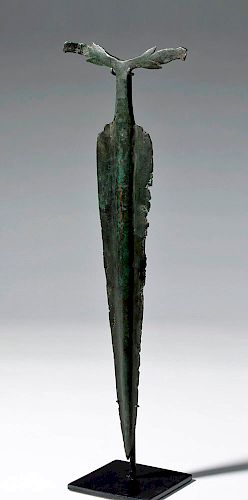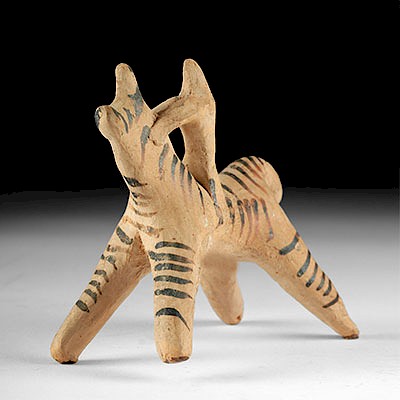Rare Caspian Sea Bronze Sword, ex-Harmer Rooke
Lot 140c
About Seller
Artemis Gallery
686 S Taylor Ave, Ste 106
Louisville, CO 80027
United States
Selling antiquities, ancient and ethnographic art online since 1993, Artemis Gallery specializes in Classical Antiquities (Egyptian, Greek, Roman, Near Eastern), Asian, Pre-Columbian, African / Tribal / Oceanographic art. Our extensive inventory includes pottery, stone, metal, wood, glass and textil...Read more
Categories
Estimate:
$3,000 - $5,000
Absentee vs Live bid
Two ways to bid:
- Leave a max absentee bid and the platform will bid on your behalf up to your maximum bid during the live auction.
- Bid live during the auction and your bids will be submitted real-time to the auctioneer.
Bid Increments
| Price | Bid Increment |
|---|---|
| $0 | $25 |
| $300 | $50 |
| $1,000 | $100 |
| $2,000 | $250 |
| $5,000 | $500 |
| $10,000 | $1,000 |
| $20,000 | $2,500 |
| $50,000 | $5,000 |
| $100,000 | $10,000 |
| $200,000 | $20,000 |
About Auction
By Artemis Gallery
Oct 25, 2018
Set Reminder
2018-10-25 11:00:00
2018-10-25 11:00:00
America/New_York
Bidsquare
Bidsquare : Antiquities from Egypt, Greece, Italy, Asia
https://www.bidsquare.com/auctions/artemis-gallery/antiquities-from-egypt-greece-italy-asia-3538
Featuring Egyptian, Greek, Roman, Etruscan, Near Eastern, plus Asian art from Central and Far East. If you love the classics, this is the sale for you. Artemis Gallery info@artemisgallery.com
Featuring Egyptian, Greek, Roman, Etruscan, Near Eastern, plus Asian art from Central and Far East. If you love the classics, this is the sale for you. Artemis Gallery info@artemisgallery.com
- Lot Description
Central Asia, Caspian Sea region, ca. 1200 to 800 BCE. A unique bronze short sword, cast in a single piece, with a wide midrib that continues into a wide tang. The tang splits in half and branches out into two terminals that look like budding, long-petaled flowers, a very rare style. This particular weapon does not bear marks of having been repeatedly sharpened for use, so it was probably made specifically to accompany a warrior in death. Comes with custom stand. Size: 5.5" W x 16.6" H (14 cm x 42.2 cm); height on stand: 17.6" (44.7 cm).
The area around the Caspian Sea, particularly on its southeast coast, and into modern day Iran, Turkmenistan, Afghanistan, and Baluchistan (western Pakistan), was a cultural hotbed during this time period. The map of archaeological finds from there is studded with urban centers, large burial mounds, and technological and metallurgical innovation - especially in the production of amazing bronze artifacts, probably with influence from the innovative bronze (and later iron) artisans in Luristan (modern day northwestern Iran). People - both men and women - went to their graves with beautiful, well-made weapons like this one that were more than likely a sign of high status.
Provenance: private Kavet collection, Massachusetts, USA, acquired in 1979 at Harmer Rooke Gallery, New York, USA
All items legal to buy/sell under U.S. Statute covering cultural patrimony Code 2600, CHAPTER 14, and are guaranteed to be as described or your money back.
A Certificate of Authenticity will accompany all winning bids.
We ship worldwide and handle all shipping in-house for your convenience.
#120290Smooth, dark green patina over surface. One side of tang has a slight bend. Losses to edge of blade, especially on one side.Condition
- Shipping Info
-
All shipping is handled in-house for your convenience. Your invoice from Artemis Gallery will include shipping calculation instructions. If in doubt, please inquire BEFORE bidding for estimated shipping costs for individual items.
-
- Buyer's Premium



 EUR
EUR CAD
CAD AUD
AUD GBP
GBP MXN
MXN HKD
HKD CNY
CNY MYR
MYR SEK
SEK SGD
SGD CHF
CHF THB
THB
















